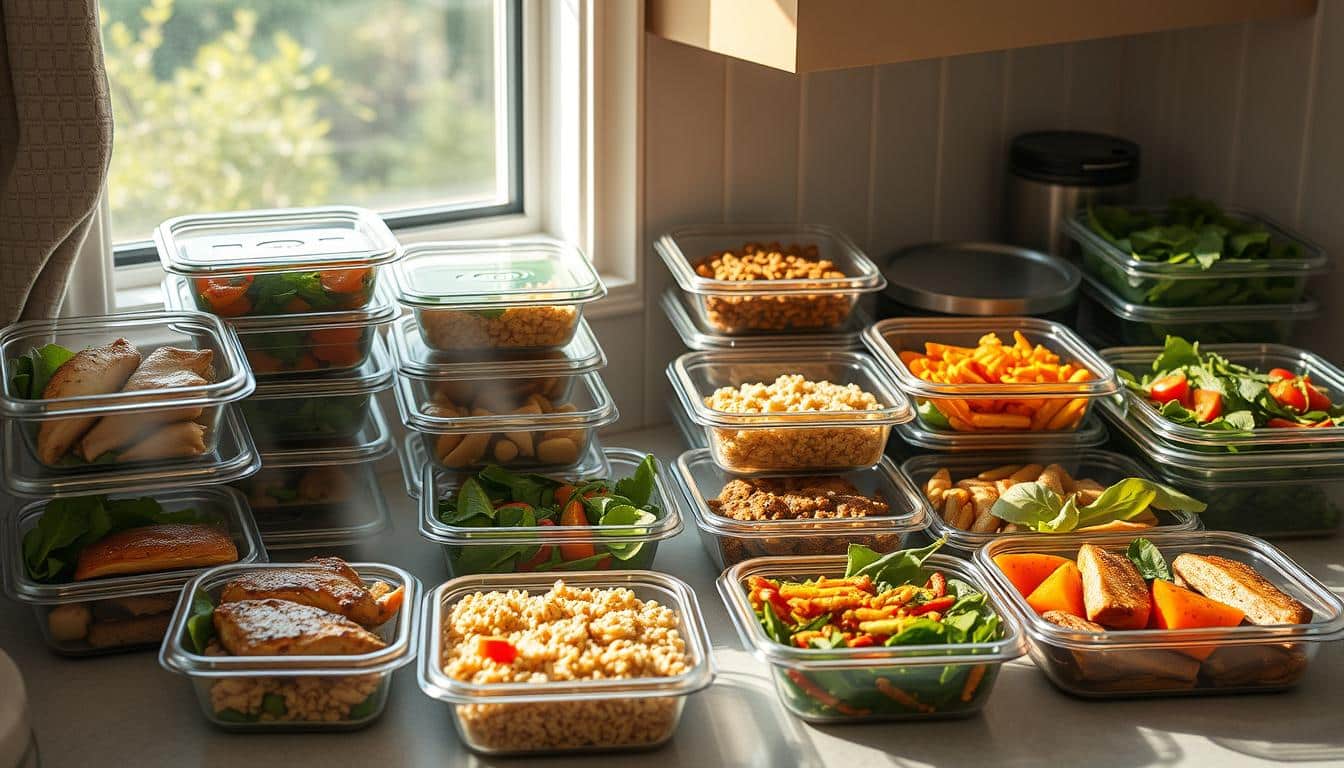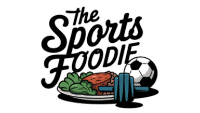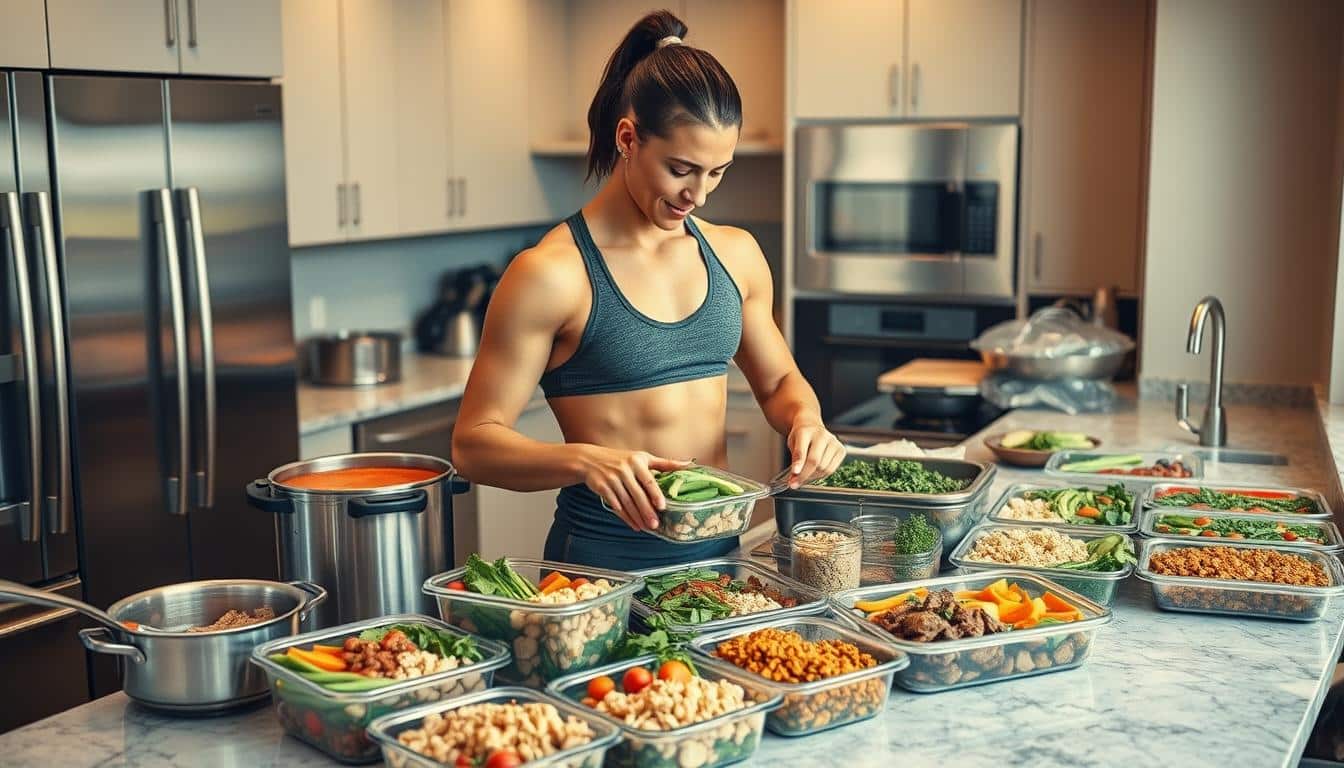Want to know a simple way to save cash, cut stress, and fuel strong training without spending all Sunday in the kitchen?
I’ve seen how a little planning changes an athlete’s week. You save money, cut food waste, and eat better with less hassle.
Smart meal prep means washing produce, chopping once, or doubling a dinner so lunch is ready. These small moves free up time and energy.
You’ll get clear tips and practical ideas that fit your schedule. We show which meals repeat on purpose so you think less and recover more.
By the end you’ll have a simple plan: one prep block that turns into many balanced meals across the week. Use this map today and keep training stress low.
Why bulk cooking helps athletes save time, money, and energy
Prep once and win the week: save time, money, and mental energy with a plan that fits your training. You spend one session to make many ready-to-eat options. That opens up more hours for sleep and work.

Key benefits for training and recovery
Planned meal prep improves nutrition and recovery. Ready meals speed post-workout refueling. You get steady carbs and protein when it matters most. A sports dietitian would call this consistent fueling.
How this reduces stress on busy days
Prepped food cuts decision fatigue. You grab, heat, and eat after a hard session. That protects your energy and helps your body recover.
- Save time: cook once, reheat many times.
- Spend less: buy planned items and waste less food.
- Reduce cleanup: fewer pots and pans across the week.
- Eat better: you choose ingredients that match your diet and goals.
- Stay flexible: scale prep up for heavy training or down during a taper.
Set your goals and plan around your training schedule
Plan your week around training windows so food work fits your life, not the other way around.
Start with the schedule. Mark hard workouts and rest days. Pick one rest or light day as your main prep block.
Map hard workouts and rest days to cooking tasks
Put tough sessions next to easy kitchen tasks like reheating or tossing a salad kit. That saves time and keeps recovery simple.
Break large tasks into segments if one long block feels heavy. A short midweek refill helps the second half of the week stay on track.
Choose meals that sit well before and after workouts
Pick pre-workout food low in fiber and moderate in fat so you move well. Keep post-workout plates rich in carbs and protein to kickstart recovery.
Have one portable option ready for late workouts or long days. Note which meal helped you feel best and repeat it next week.
![]()
Pick a practical number of meals and snacks per day
Decide a realistic number of daily eats you can repeat. Many athletes choose three main meal and two snacks to spread carbs and protein.
Answer simple questions: “When am I hungriest?” and “When do I have the most time?” Use those answers to set small prep blocks and a backup plan.
- Start with training and mark the best cook day.
- Choose meals that digest well around a workout.
- Keep one quick prep midweek to refill staples.
Smart budget shopping for a high-protein, high-carb week
Shop with a simple rule: buy what’s on sale, in season, and suits your training days. That gives you cheap, fresher produce and fewer surprises at checkout.
Build your grocery list around overlap. Pick staples that repeat across a few meals. One bag of rice, a pack of tortillas, and a tub of yogurt should appear on many entries.
Practical store and pantry choices
- Choose frozen fruit and steamable vegetables to cut waste and prep time.
- Buy store brands for oats, rice, beans, and canned tomatoes to save money.
- Add snack foods: yogurt, cottage cheese, nuts, fruit, crackers, and hummus.
- Plan one recipe per protein so you can reuse it across a couple of meal ideas.
| Item | Why buy | Uses (example meal) | Cost tip |
|---|---|---|---|
| Rice | Fills carbs, stores long | Rice bowls, stir-fry, sides | Buy store brand 10-lb bag |
| Frozen veggies | Less waste, no chopping | Sheet pan, bowls, quick stir | Choose steamable packs |
| Chicken (fresh/rotisserie) | Flexible protein | Sheet pan, tacos, salads | Use rotisserie for speed |
| Oats & yogurt | High-carb and snack staples | Overnight oats, parfaits | Pick regular store brand tubs |
Last step: keep a short midweek list on your phone and check items off while you shop. This stops impulse buys and keeps your plan tight.
Bulk cooking meals for athletes: core strategies
Spend an hour to set up multiple quick lunches and dinners that feel fresh each day.
Cook once, eat multiple times
Double or triple dinner so lunch is ready. Cook a little extra and stop the next-day scramble.
Batch staples and smart swaps
Batch rice, oats, beans, and roasted veggies. Store one plain batch and one seasoned batch to widen options without extra work.
Use rotisserie chicken for fast protein
Buy a rotisserie chicken and break it into portions. It stretches into wraps, soups, salads, and bowls.
- Portion while warm to speed storage and cleanup.
- Keep sauces in jars to change flavors day-to-day.
- Use oven time to roast extra sweet potatoes or proteins in the same slot.
| Staple | Why it helps | Quick uses |
|---|---|---|
| Rice | Long shelf life, fast carbs | Bowls, sides, stir-ins |
| Oats & Beans | Cheap, filling protein and carbs | Overnight oats, chili, salads |
| Rotisserie chicken | Ready protein, saves time | Wraps, soups, grain bowls |
| Roasted veggies | Versatile, low waste | Sheet pan sides, salads, bowls |
Essential tools that cut hours off prep and cleanup
A few smart tools can shave hours off weekly food prep and cleanup. Use them to move work out of your hands and into appliances. That frees up time for training, rest, or just a real sit-down dinner.
Slow cooker, Instant Pot, and rice cooker roles
Slow cookers run all day with almost no attention. They make tender proteins and soups while you train.
Instant Pots finish beans, grains, and shredded protein in a fraction of the time. They are great when you need fast batch results.
Rice cookers produce steady rice and other grains without babysitting. Start a pot, then prep other ingredients while it works.
Steamable veggies and microwave tricks
Steamable veggie bags save chopping and pans. They give a fresh side with minimal cleanup.
When reheating, add a splash of water and cover. The microwave revives rice and protein without drying them out.
- Load tools before a run so a hot meal waits when you return.
- Keep lids and liners tidy to cut cleanup from hours to minutes.
- Choose stackable containers and label lids with tape and date.
- Pin a short list of tool tips on the fridge so everyone can help.
| Tool | Best use | Why it saves time | Quick tip |
|---|---|---|---|
| Slow cooker | Shredded protein, soups | Hands-off, long low heat | Layer ingredients cold and set timer |
| Instant Pot | Beans, grains, fast braises | Cuts hours to minutes | Use natural release for tender results |
| Rice cooker | Rice, quinoa, porridge | Consistent results, no watch | Rinse grains to improve texture |
| Microwave + steam bags | Sides and reheating | Fast, few dishes | Cover and add water to keep food moist |
One-pot and sheet pan frameworks that never get old
One-pan roasts and single-pot skillets cut cleanup and keep dinners reliable all week. Use a clear framework so you can build a balanced plate in minutes.
Balanced sheet pan: protein, carb, veggie
Build: pick one protein, one carb, and one veggie. That makes balance automatic.
Toss with oil, salt, and spices. Roast until the protein is cooked and the veg is tender.
One-pot ideas: taco skillet, pasta, and grain bowls
Try a one-pot taco skillet with ground turkey, rice, beans, and salsa for a full meal. Or make a one-pot pasta with jarred sauce and extra veggies.
Grain bowls are another pot-friendly option: start with rice or quinoa, then add protein, veg, and a bold dressing.
Flavor add-ons: dressings, marinades, and toppings
Change the vibe with a simple marinade, a citrus dressing, or crunchy toppings. Small add-ons make repeated plates feel new.
Pantry wins for fast assembly meals
Keep beans, tuna, pasta, broth, and canned tomatoes handy. These pantry ingredients speed no-cook assembly and emergency recipes.
- Do five minutes of prep the night before so your pan hits the oven right after work.
- Save a recipe card for each favorite combo to rotate without thinking.
- Pack a second meal from the same pot while it is still warm to lock in freshness.
| Framework | Quick build | Why it works |
|---|---|---|
| Sheet pan | Protein + carb + veggie | Balanced, low cleanup |
| One-pot taco skillet | Ground meat + rice + beans + salsa | Fast, hearty, single vessel |
| One-pot pasta | Pasta + sauce + veggies | Comforting, minimal prep |
Protein-forward batches that fuel workouts
Make protein the anchor of your weekly prep so every plate helps training and recovery. Cook once and you’ll have quick options that suit hard sessions and easy days.
Protein choices and clear portioning
Cook a large batch of chicken breasts, ground turkey, fish, or plant proteins like beans and lentils. Keep textures simple so you can reuse proteins across different dishes.
Portion into 4–6 oz packs. Seal and label each pack so every athlete meal is grab-and-go. That size supports recovery without overfilling your body.
How to use and vary one batch
- Pair proteins with rice, potatoes, or pasta to make a complete meal.
- Season half the batch plain and half with one spice blend. Two flavors reduce repetition fatigue.
- Keep small jars of pesto, salsa, or yogurt-tahini to change the same plate fast.
- Freeze extras to protect variety and add an emergency athlete meal to your fridge stash.
| Protein | Best uses | Storage | Portion |
|---|---|---|---|
| Chicken breast | Wraps, bowls, salads | Fridge 4 days / freezer 3 months | 4–6 oz per pack |
| Ground turkey | Skillets, tacos, soups | Fridge 3 days / freezer 3 months | 4–6 oz per pack |
| Fish | Bowls, pasta, quick grills | Fridge 2 days / freezer 2 months | 4–6 oz per pack |
| Beans & lentils | Chili, salads, rice bowls | Fridge 4 days / freezer 3 months | 4–6 oz protein-equivalent |
Storage, food safety, and freezer use
Safe storage starts the second your food leaves the stove. Cool fast, portion smart, and label clearly. Do this and your meal prep stays tasty and safe.
Fridge and freezer timelines for cooked foods
Refrigerate cooked foods within two hours. Use cooked plates within 3–4 days.
Freeze items you won’t eat within 3–4 days. Most cooked proteins last 2–3 months in the freezer.
How to cool, portion, and label meals
Move hot food into shallow containers so it cools faster.
Portion while warm so scooping is easy and lids seal well.
Label each container with name and date. Eat older items first.
Freezer tools: containers and portion trays
Use airtight containers and portion trays like Souper Cubes for soups and sauces.
Keep foods in similar container sizes so stacking is simple and space-efficient.
- Store ingredients in clear bins so you see what needs using soon.
- Keep a short freezer list on your phone so you pull meals in the right order.
- Reheat evenly and stir halfway to maintain consistent temperature.
- Set a weekly prep reminder to cycle older meals forward.
Common questions — quick checklist:
- How fast did I cool it? — Under 2 hours.
- Did I label it? — Name and date.
- Is it in an airtight container? — Yes = freezer-ready.
- Do I have a running list? — Phone list updated.
| Action | Why it matters | When to do it | Tool example |
|---|---|---|---|
| Cool in shallow pans | Speeds safe cooling to under 2 hours | Immediately after cooking | Shallow plastic or aluminum pans |
| Portion while warm | Easy scooping and better seals | Within first hour | Portion trays, ladles |
| Label with name + date | Prevents waste and confusion | Before fridge/freezer storage | Masking tape + marker |
| Use airtight trays | Protects flavor and prevents freezer burn | When freezing soups/sauces | Souper Cubes, BPA-free containers |
Seven-day sample prep map and recipe ideas
Start the week with one short session and you’ll have quick lunches and easy dinners all week.
Weekend prep: grains, proteins, roasted veggies, oatmeal
Do this: cook a big pot of rice, roast two sheets of veg, and batch two proteins.
Make a tub of oatmeal for breakfasts and portion two lunch packs per person. Portion sauces and dressings so bowls come together in minutes.
Weeknight refresh: quick pasta, bowls, soup, eggs
Monday: warm a protein with rice and roasted veg for a fast dinner.
Tuesday: spin up a quick pasta and save two lunch boxes for Wednesday.
Wednesday: build bowls with leftover grains and fresh toppings, then pack a lunch.
Budget-friendly athlete meals: soups, skillets, and pasta
Thursday: heat a soup and add bread or a cheese quesadilla.
Friday: finish a skillet taco mix in the pan and toss in greens. Pack lunches while dinner cools to lock in the next day’s lunch without extra steps.
Rotate these recipes each week to keep variety while you reuse the same prep map. For plant-based options, see plant-based recipes.
| Day | Main | Quick prep | Pack tip |
|---|---|---|---|
| Monday | Batch protein + rice | Reheat and steam veg | Pack extra lunch |
| Tuesday | Quick pasta | Boil 10 min | Save two portions |
| Thursday | Chicken tortilla soup | Heat pot | Add bread or quesadilla |
| Friday | Skillet taco mix | One-pan finish | Top with greens |
Conclusion
A small prep habit can free hours and make every workout easier to fuel and recover from. Pick one simple routine and stick to it. That one habit saves you time and lowers stress all week.
Keep your plan short. Repeat the meal and two recipes you like. Use overlapping ingredients, a tight grocery list, and your favorite tools. Portion protein and carbs so each day supports training and recovery.
Pack the night before. Let a dietitian check your plan if you want extra advice. Simple wins beat perfect plans — do less, win more, and keep your energy steady.


